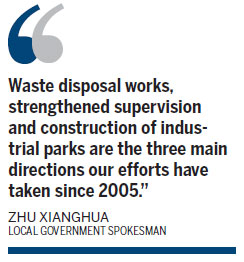According to research done by an environmental non-governmental organization into Xintang town in Guangdong in 2011, which produces a similar quantity of jeans as Fumian, the domestic market leader, the amount of chemicals - copper and cadmium- in the mud of a river bed in the town was over the limit allowed under the State's standards. The cadmium content in one sample was as much as 128 times what is considered to be the safety limit.

The measure indicates how serious the pollution problem is in Fumian.
The data provided by China National Textile and Apparel Council came from 133 textile industrial groups across East and South China, most of which have similar environmental issues, analysts warn.
In addition to the heavy metals of lead and cadmium, both toxic to humans, the textile and apparel industry, the third-largest discharger of industrial waste in China, also widely uses nonyl phenol, octyl phenol and perfluorooctane sulfonatel, which have been dubbed "environmental hormones". They are said to affect human fertility.
"The Chinese textile industry is concentrated in Guangdong, Fujian, Shandong, Zhejiang and Jiangsu. The overall volume of textile printing and dyeing in China is so huge, yet scattered across thousands of mills, that it is very difficult to treat the pollution quickly and effectively," said Xi Danli, a researcher of textiles at the Shanghai-based Donghua University.
"Concentrating the enterprises in industrial parks is the first step toward addressing the issue before technological upgrading and innovation is instituted."
The water pollution in Fumian is treated in different ways by different parties.
Compelled by grave environmental concerns, the Fumian government started looking at the jeans industry, which contributes to a large share of its revenue, from a variety of angles.
"Waste disposal works, strengthened supervision and construction of industrial parks are the three main directions our efforts have taken since 2005," said Zhu Xianghua, a local government spokesman.
Yet local residents, who are the main victims of the pollution, are divided when it comes to tackling the pollution issue of the jeans industry.
One anonymous resident said: "Most of my family works in the factories. Some of my relatives are business owners of the jeans factories. It is fair game for everyone: Get rich first and then you have the ability to solve the pollution."
Another resident held a different view: "That's not the way it works. The truth is many businessmen leave for other places or emigrate to foreign countries after making their money. What the government does is far from enough. Taxes, raising water prices and electricity costs are all useful tools to force the factories to upgrade their industrial procedures and use more environmentally friendly technology."
Although the Chinese government vows to draw lessons from the pollution of East China in developing China's vast inland area, Fumian's case drives home how difficult it is to get rich quick without hurting the environment and people's health, especially before Chinese enterprises build real competitiveness in innovation and local governments redefine the meaning of growth.
Environmentalists say it is a major concern to see clean water and air in Central and West China contaminated before people realize how valuable they are.
They say to keep a check on the worsening tendency, the central government needs to further integrate the development of different regions of China, calculate environmental costs and include research and development into its measure of economic growth.
